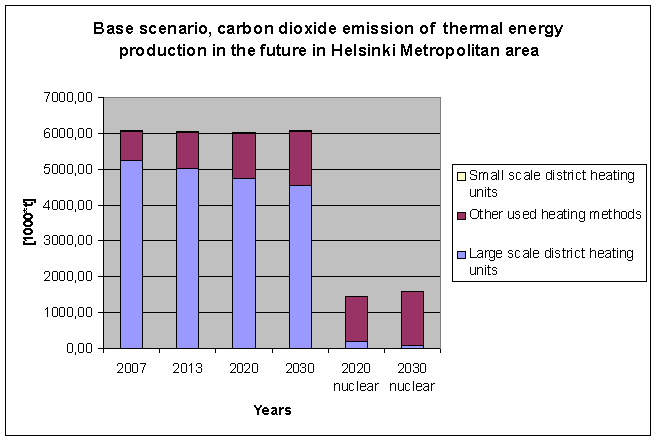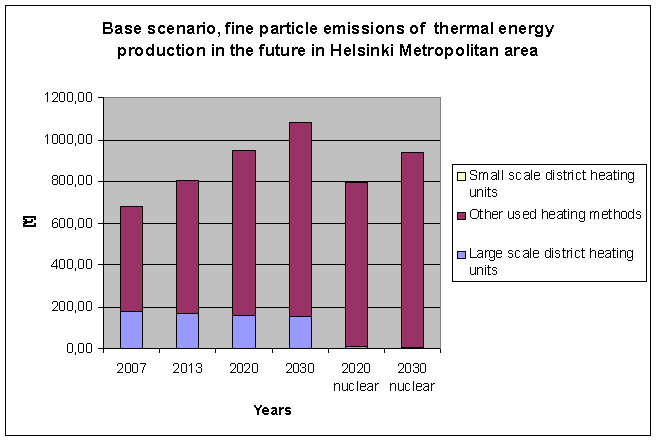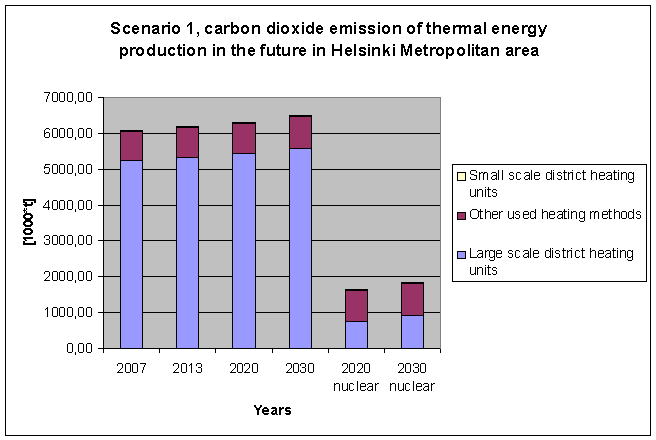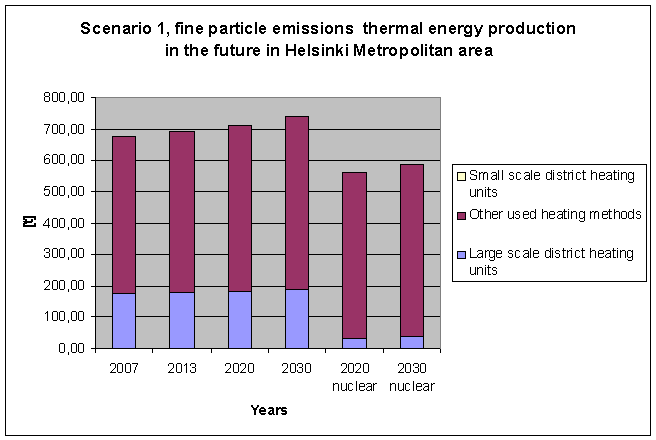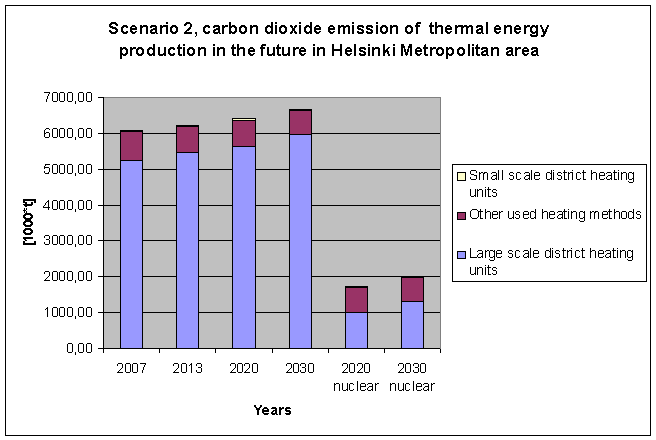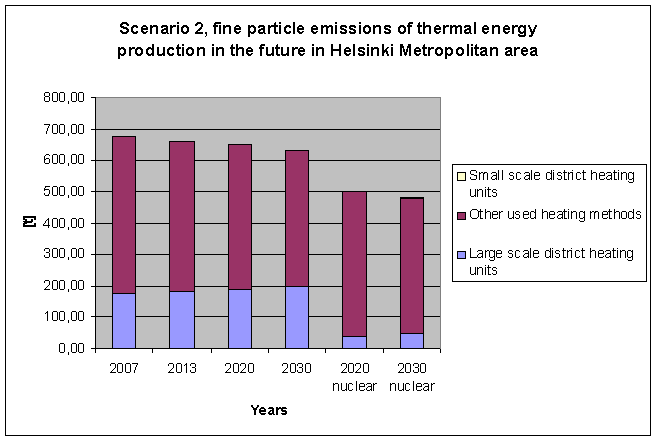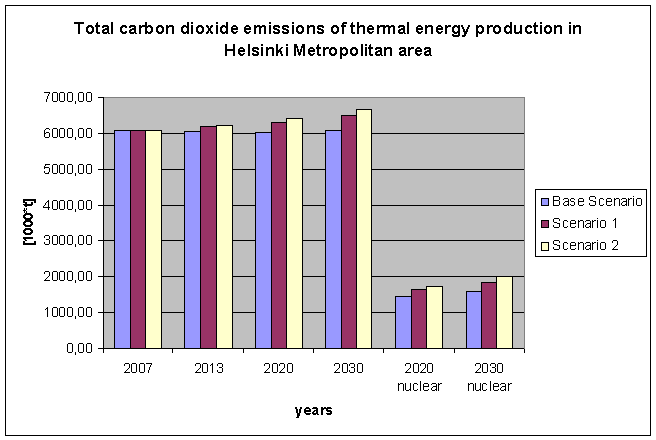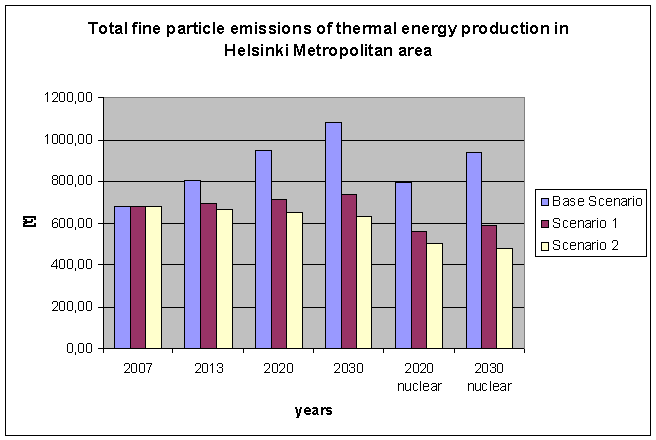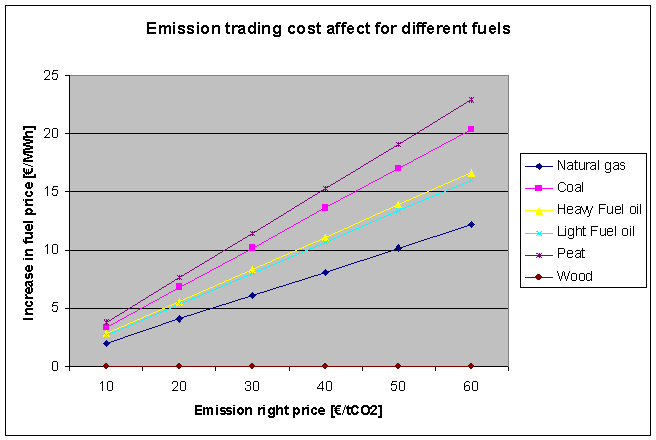Emission assessment of small-scale energy production in the Helsinki metropolitan area
| Moderator:Psorsa (see all) |
|
|
| Upload data
|
Contents
Scope
Purpose
The main purpose of this assessments is to evaluate greenhouse gas emissions and emission trading cost of small-scale energy production in Helsinki Metropolitan Area. In this assessment small-scale energy production is set to mean other used heating methods than district heating and those district heating units, which fuel thermal energy output is less than 50 MW.
Also potential of the possible new nuclear plant to produce thermal energy to district heating network of Helsinki and the affects are assessed.
Boundaries
- Spatial: Helsinki Metropolitan Area (Helsinki, Espoo, Vantaa, Kauniainen).
- Emissions: CO2, PM2.5.
- Heating methods:
- District heating
- The others
- Fuels: All (H/L oil, Wood based fuels, Gas, Coal).
- Other impacts: Cost
- directly from the activity itself of the greenhouse trade
Scenarios
Common to the all scenarios:
- No new small-scale district heating units
- Other used heating method fractions are same as in 2007
- 2020 Nuclear and 2030 Nuclear in the following figures mean situations, where the new nuclear plant is built to Loviisa and connected to district heating network of Helsinki.
Base scenario:
- District heating network will be same as in 2007
- No expansion to the network
Scenario 1:
- District heating buildings floor area fraction of the total floor area in cities is same as in 2007
- 665 km expansion to the network
Scenario 2:
- District heating buildings floor area fraction of the total floor area in cities increases same rate as between years 2000 and 2008
- 890 km expansion to the network
Intented users
- Local district heating distributors in Helsinki Metropolitan Area
- General public
- Scientists working on climate change and related fields of study
Participants
- The Assessment and Modeling unit, National Institute for Health and Welfare of Finland, THL.
- Jouni Tuomisto (leading researcher, person in chrage)
- Pasi Sorsa (assisting researcher, executing the assessment)
- Funded by Bioher-project
Definition
Gabi 4.3 - life cycle assessment software model parameters: File:Parameters, gabi-model.xls.
All the starting values are listed and calculations are made in the excel file; File:Assessment of small-scale energy production in Helsinki Metropolitan area.zip
Gabi-model can be loaded from here: File:Gabi-model.zip
Decision variables
Indicator variables
- Cost
- Emissions
Other variables
Indicies
- Time: Years 2007, 2013, 2020 and 2030.
Analyses
- Analyses for small scale district heating plants and other used heating methods in Helsinki Metropolitan Area
- fine particles PM2.5 and CO2 emissions
- emission trading cost
Result
Results
Base scenario: District heating network is the same as in 2007.
Emissions:
Scenario 1:
District heating network is expanded so, that district heating buildings fraction of the total floor area in cities are same as in 2007 in Helsinki Metropolitan area.
Emissions:
Scenario 2: Buildings, which use district heating, floor area fraction of the total floor area in cities increases as in figure 1.
Emissions:
Differences between the scenarios:
Costs: Emission trading affect on fuel prices is presented in figure 2.
Figure 2. Emission trading affect on fuel prices.
Pöyry Energia Oy has assessed that emission trading price will increase to 31 €/tCO2 in year 2030. In European Union assessments has been evaluations that emission right price could even be 60 €/tCO2.
Building cost of district heating network to year 2030 is presented in following table.
| . | . | . | . | Scenario 1 | Scenario 2 |
| . | Base Scenario | Scenario 1 | Scenario 2 | Nuclear | Nuclear |
| Length of main district heating network line in Helsinki Metropolitan area [km] | 2431,2 | 2431,2 | 2431,2 | 2431,2 | 2431,2 |
| Total floor area of buildings, which are heated by district heating, in Helsinki metropolitan area [km2] | 58,1 | 58,1 | 58,1 | 58,1 | 58,1 |
| Main district heating network line / total floor area of buildings, which are heated by district heating [km/km2] | 41,8 | 41,8 | 41,8 | 41,8 | 41,8 |
| Floor area increase of buildings in 2030, which are heated by district heating [km2] | 0,0 | 15,9 | 21,3 | 15,9 | 21,3 |
| New main district heating network line [km] | 0,0 | 665,6 | 890,9 | 665,6 | 890,9 |
| Building cost per new district heating line [€/km] | 218000,0 | 218000,0 | 218000,0 | 218000,0 | 218000,0 |
| Building cost of new district heating network [M€] | 0,0 | 145,1 | 194,2 | 145,1 | 194,2 |
| New separate residential houses connected to district heating network | 0,0 | 39248,8 | 40930,3 | 39248,8 | 40930,3 |
| New apartment buildings connected to district heating network | 0,0 | 8156,5 | 8505,9 | 8156,5 | 8505,9 |
| Building cost for customers [M€] | 0,0 | 323,5 | 337,4 | 323,5 | 337,4 |
| Total building cost [M€] | 0,0 | 468,6 | 531,6 | 468,6 | 531,6 |
If then assessed that these building costs and emission trading cost would be the reduction cost of fine particle emissions, then the reduction cost by extending district heating network are as follows
| . | . | . | Base Scenario - Scenario 1 | Base Scenario - Scenario 2 |
| . | Base Scenario - Scenario 1 | Base Scenario - Scenario 2 | Nuclear | Nuclear |
| Revenue [%] | 5,0 | 5,0 | 5,0 | 5,0 |
| Annual installment factor [%] | 12,95 % | 12,95 % | 12,95 % | 12,95 % |
| Price of emission right [€/tCO2] | 23,0 | 23,0 | 23,0 | 23,0 |
| Building cost [M€] | 468,6 | 531,6 | 468,6 | 531,6 |
| Reduction of total fine particle emission [t] | 343,2 | 451,1 | 347,0 | 454,6 |
| Investment cost [M€/a] | 60,69 | 68,85 | 60,69 | 68,85 |
| Emission trading cost[M€] | 23,5 | 32,0 | 19,0 | 27,5 |
| Fine particle reduction cost [€/kgPM2,5] | 245,288 | 223,646 | 229,543 | 211,933 |
Conclusions
Main purpose of this assessment was to calculate fine particle and carbon dioxide emissions of small-scale energy production in Helsinki Metropolitan area in 2013, 2020 and 2030.
Consumption of district heating has been around 12 TWh each year in Helsinki Metropolitan area in the past. In this assessment calculated that total consumption of thermal energy will be about 940 TWh higher in the year 2030 in Helsinki Metropolitan area. If district heating fraction of the total energy production would be remain at 2007 level, the district heating consumption would be increased 615 GWh. This would mean 27 GWh increase in consumption of district heating each year, which has been 40 GWh/a last 8 years.
Small-scale district heating unit emissions can be estimated to increase slightly or remain at 2007 level in the year 2030, because those units production will also remain at the 2007 level. Most of the small-scale district heating units are in separate district heating network or not used to even out the peaks in need of thermal energy in Helsinki Metropolitan area.
Other used heating methods emissions area highly dependent of district heating network and extension of it in Helsinki Metropolitan area . If district heating buildings floor area fraction of the total floor area is kept as in 2007, fine particle and carbon dioxide emissions of the other used heating method are increased about 10 %.
If the new nuclear plant would be connected to the district heating network of Helsinki Metropolitan area, the total carbon dioxide emissions of energy production can be estimated to drop 70 % based on the model calculations. Fine particle emissions are more dependent of district heating network coverage, because the other used heating methods are the main source of fine particle emissions. Notable is that in the calculations large scale energy production units changes are not taken into account.
More accurate calculations would acquire calculations and studies about buildings overall heat transfer coefficients and proportions of used heating methods in the area in the future.
Emission trading affect on fuel prices is evaluated in many assessments and as figure 2 shows, it would affect prices of peat and coal the most. In the report of future of district heating and cooling, it is estimated that in the future coal will not be used as much as it has been used and peat and natural gas use will increase. Major structural changes most likely wont happen in energy production in Helsinki Metropolitan area as the report evaluates, if the new possible nuclear plant is not connected to the district heating network.
See also
- District heating in wikipedia
- Thermal energy need in Helsinki Metropolitan Area
- Gabi 4.3 - life cycle assessment software
- District heating production units in Helsinki metropolitan area
